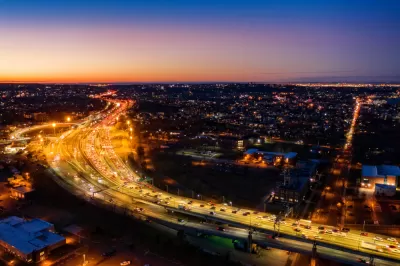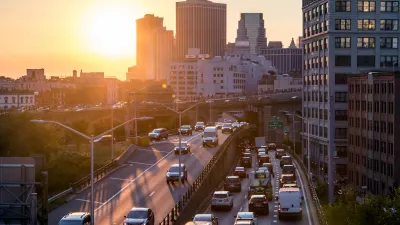New travel patterns and an increased reliance on delivery services and ride-hailing are creating more congestion in New York's outer boroughs.

While Manhattan traffic has seen some relief during the pandemic, other boroughs are experiencing increases in congestion as the pandemic shifts traffic patterns in the city. As Winnie Hu, Patrick McGeehan and Nate Schweber report, "Some neighborhoods are being choked by more vehicles than they have ever seen before, with traffic snarls fueled by a plunge in transit use and car pooling, soaring car ownership and a surge in delivery trucks trying to keep up with an e-commerce boom."
Highways in Brooklyn, Queens, and Staten Island are feeling the pain, with the Brooklyn-Queens Expressway now being the most congested street in the city. Average travel speeds have also fallen on other major arteries. "During the pandemic, Mayor Bill de Blasio, whose time in office ends on Friday, has encouraged people not to drive, and the city has added a significant number of bus and bike lanes. Mr. de Blasio’s successor, Eric Adams, an avid cyclist, has promised to build on those efforts." The new mayor also wants to develop efforts to manage traffic using technology and regulate truck deliveries.
According to former city traffic commissioner Samuel I. Schwartz, the city is "reaching a point where the highway system is overloaded" thanks to increased truck traffic and ride-hailing rides. The congestion has stalled public buses and caused the MTA to shut down or detour certain routes to avoid traffic. "The pandemic has also turned many New Yorkers into car owners as they have abandoned public transit because they’re afraid of the virus or crime."
A proposed congestion pricing scheme designed to discourage driving and reduce traffic has been delayed until at least 2023.
FULL STORY: As Traffic Roars Back, Neighborhoods Outside Manhattan Feel the Pain

Planetizen Federal Action Tracker
A weekly monitor of how Trump’s orders and actions are impacting planners and planning in America.

Congressman Proposes Bill to Rename DC Metro “Trump Train”
The Make Autorail Great Again Act would withhold federal funding to the system until the Washington Metropolitan Area Transit Authority (WMATA), rebrands as the Washington Metropolitan Authority for Greater Access (WMAGA).

The Simple Legislative Tool Transforming Vacant Downtowns
In California, Michigan and Georgia, an easy win is bringing dollars — and delight — back to city centers.

The States Losing Rural Delivery Rooms at an Alarming Pace
In some states, as few as 9% of rural hospitals still deliver babies. As a result, rising pre-term births, no adequate pre-term care and "harrowing" close calls are a growing reality.

The Small South Asian Republic Going all in on EVs
Thanks to one simple policy change less than five years ago, 65% of new cars in this Himalayan country are now electric.

DC Backpedals on Bike Lane Protection, Swaps Barriers for Paint
Citing aesthetic concerns, the city is removing the concrete barriers and flexposts that once separated Arizona Avenue cyclists from motor vehicles.
Urban Design for Planners 1: Software Tools
This six-course series explores essential urban design concepts using open source software and equips planners with the tools they need to participate fully in the urban design process.
Planning for Universal Design
Learn the tools for implementing Universal Design in planning regulations.
Smith Gee Studio
City of Charlotte
City of Camden Redevelopment Agency
City of Astoria
Transportation Research & Education Center (TREC) at Portland State University
US High Speed Rail Association
City of Camden Redevelopment Agency
Municipality of Princeton (NJ)





























